Abstract
Agroecology can be considered an approach to farming and food systems which integrates the use of ecological principles and biological cycles methods of the traditional systems to the design and management of sustainable agriculture. Despite some differences mainly due to specific national developments on the topic, today there is a substantial convergence in the belief that the term agroecology reconciles three dimensions: scientific discipline, social movement, cultural practice. Beyond the deep-rooted French experience, at the level of the European Union (EU) there is no clear strategy for agroecological practices and action plans. In the Italian case, a first step forward, especially in terms of initiatives, was taken following the universal exhibition “EXPO 2015 Milan” while with respect to the promotion of agroecological practices, some positive feedback is ascribable to the experience of the Bio-districts. The purpose of this study is to investigate whether the model adopted by the Italian multifunctional farms can be considered precursory with respect to the approach that, from a theoretical point of view, identifies agroecology. The Italian system on farms diversification would seem to show it has somehow anticipated the new European Green Deal strategy for the next ten years due to the simultaneous presence of key elements that concern not only agricultural practice but also ethical and social aspects by involving farmers and communities that insist on the territory. Green Deal and Farm to Fork strategies recognize a new and important role for the agriculture and agri-food sectors and to invite farmers to engage consumers’ interest. The study also considers some characteristics of the farmers, such as the level of education and the economic sector in which they were employed before devoting themselves to the agritourism business but also the ability to develop multi-actor and multi-level networks. The analysis of these determinants would allow them to place different professional skills at the service of the primary sector that tend to positively influence the organization and farm performance. At the same time, the farmers’ skills are influenced by different sectors of activity such as participation in research projects or even in local initiatives with public and private actors. This allows the agroecological approach to be put into practice in a conscious (or unconscious) way.
1. Introduction
Wezel et al. [1] (pp. 2–3) highlight how agroecology is a dynamic concept that has gained importance in scientific, agricultural and political discourse in recent years. This has led to a certain convergence of the definitions and principles of agroecology. Recognizing the transdisciplinary nature of an agroecological approach, in the present work this term refers to three dimensions such as a scientific discipline, a set of practices and a social movement in accordance with Francis et al. [2], Méndez et al. [3], Altieri [4], van der Ploeg et al. [5].
The European Union (EU) rural development policy anchors on an integrated territorial approach to development, which looks at the definition of growth objectives and at the complementarity of the tools, resources and interventions implemented.
Support for farms diversification has found and still is, support from the European rural development policy which has seen in the multifunctionality [6,7,8,9,10] a lever for the socio-economic development of the rural context and, consequently, for the rooting of the local population on the territory. However, the diversified farm not only addresses the typical problems of the European rural areas—such as ageing population, decline in employment, rural exodus—but it is also able to respond to the increasingly “vital” needs for man and for society such as the preservation of the territory and its rural heritage, the availability of services, the start of new business activities and sources of income, the salubrity of productions and of the environment.
Thus, since there is no clear EU strategy for agroecological practices and action plans, even in Italy there is no specific program, although the organic sector has proposed concrete agroecological solutions for the agricultural and agri-food system.
The Italian system of farm diversification is among the most innovative and structured in Europe. Despite its most evident aspect is linked to the agritourism phenomenon which appears to be consolidated and well-known, the system tends to create new forms of related activities for which a greater in-depth data analysis and knowledge of their economic relevance and of their territorial impacts is necessary.
Among these, it is worth mentioning the experience of the Bio-districts, also promoted by the Italian Association of Organic Agriculture, where different actors work together for the sustainable management of local resources, based on the principles and models of organic farming, where social, economic, ethical and environmental dimensions are included [11].
More recently, Italy, following the universal exhibition “EXPO 2015 Milan,” dedicated to the theme ‘Feeding the Planet,’ has developed interesting initiatives about a cultural progress in the agroecology sector that gave life to a parallel forum called “People’s EXPO.” The latter was attended by 180 delegates from 54 countries representing 14 international networks. The forum closed with the drafting of the manifesto “Food Sovereignty and Agroecology” aimed at “curing sick food systems” through the adoption of measures to promote agroecology as a way of life and to refuse its co-optation by the industrial food system of the world networks [12].
In this manifesto, it has been reported that agroecology is meant as a holistic and an inclusive system of food production and distribution through direct, fairs and self-governing chains of sale. These practices are based on ecological principles that drastically reduce dependence on external inputs. The strategies to promote agroecology include the adoption of adequate hygiene and health regulations, horizontal and intergenerational exchanges of knowledge, be recognized as a primary solution to climate change and to fight the attempts of the private and public sectors to appropriate it as a means of promoting Genetically Modified Organisms (GMOs).
In continuity with this action, the People’s EXPO Committee was established with the aim to disseminate the contents of the manifesto on the Italian territory and to use it as a tool for evaluating Italian and European policies which have to do with the right to food and the transition to more just and sustainable agri-food systems after 2015. Among these activities, there is the Campaign for Farming Agriculture, with the dual purpose of: (1) informing the public and let debate the experts on existing laws and practices that hinder or favor peasant agriculture in Italy; (2) making proposals about new practices, new laws and possible convergences that give peasant agriculture the space and dignity they deserve.
That said, the present research has been carried out with the intention of investigating whether the model adopted by the Italian multifunctional farms can be considered precursory with respect to the approach that identifies agroecology from a theoretical point of view. The authors’ aim also consists to create a common basis for reflecting on the following issues:
- Are there any similarities between the national model of multifunctional farm and the agroecological approach?
- What are the agroecological determinants found in the Italian multifunctional farms?
A dataset provided by the “Eccellenze Rurali” (Rural Excellence) project is used to develop the research, which is based on 102 farms, distributed throughout the country, supported by rural development policies [13]. Among them, 20 farms with high multifunctional characteristics have then been selected.
Furthermore, the research draws on the experience of 3 multifunctional farms carrying out agroecological practices to evaluate if this approach can be considered a model for agriculture and farming towards Europe 2030 targets [14].
The European strategy for 2030, which supports the ecological transition of agriculture and the agri-food system, directly recalls the principles of agroecology. It promotes sustainable agricultural models, based on elements such as organic farming, the reduction of chemical inputs, recovery of biodiversity, networks for innovation.
2. The Theoretical Approach: Agroecology as a Scientific Discipline, as a Movement, as a Practice
Agroecology can be considered an approach to farming and food systems which integrates the use of ecological principles and biological cycles methods of the traditional systems to the design and management of sustainable agriculture. Rather than a discipline, it has roots in the agricultural sciences, in the environmental movements and in rural development studies [2,3,4,5].
The use of natural resources, depending if they are produced in the farm or obtained through exchanges between farmers and other actors in the agricultural chain, is fundamental and has a high degree of autonomy which has implications in the economic and ecological resilience.
Although initially agroecology dealt with crop production and preservation of the agricultural system, in recent years new dimensions such as environmental, social and economic issues are becoming relevant. The term agroecology can be considered a scientific discipline, as a set of agricultural practices and as a social or political movement, depending on its historical evolution in different countries. For instance, in France agroecology was meant as a farming practice and as a movement [15]. In Germany, agroecology was meant as a scientific discipline, while in the USA and in Brazil, it concerns all three dimensions, with a predominance of agroecology as a science in the USA and as a set of agricultural practices and a movement in Brazil [16].
As a science, agroecology gives priority to research, participatory approaches and transdisciplinarity, which include the study of the whole food systems by encompassing the ecological, economic and social dimensions and their principles to the design and management of a sustainable agriculture.
As a movement, agroecology defends farmers and rural communities, local and short food chains, diversity of seeds and breeds, quality of food. It is seen as an answer to how to transform the raw material for a food system and to repair the rural world which has been devasted by intensive industrial agricultural production. It can be a group of farmers working for food security and sovereignty or for extending alternative agriculture to better respond to higher common purposes such as sustainable agriculture.
To this aim, the diverse forms of agroecological food production generate local knowledge, promote social justice and strengthen the identity and culture of rural areas not conforming to the industrial model but rather by building local food systems based on agroecological production.
As a set of agricultural practices, agroecology is based on a sustainable use of natural resources, knowledge and priorities of local farmers and a wise use of biodiversity and solutions to provide benefits at environmental, economic and social level both at local and global level. Agroecological practices are seen as new, modified or adapted contributing to a more ecological agriculture or techniques for low external input systems by imitating natural processes and creating biological interactions and synergies in the agroecosystems [17]. These practices aim to produce significant amounts of food and contribute to improving the sustainability of agroecosystems by valorizing in the best way ecological processes and ecosystem services such as soil, water and biodiversity conservation, regulation of pests at natural level, nutrient cycling [16]. They involve improvements where farmers share their experiences through on-farm experimentation and applied research representing a process of making agriculture more sustainable and more resilient. Finally, different agroecological practices show they increase incomes, create more employment and strengthen the resilience of farms and rural areas [5].
But despite the existence of different approaches and definitions, the new views and dimensions brought agroecology to be considered a scientific discipline to help facilitate the efforts of farmers and academics who are searching for innovative ways to increase productivity and sustainability of agriculture while preserving the environment and providing quality of life [2]. This approach was followed by an integration of concepts and methods from the social sciences to better understand the agriculture which emerges from sociocultural contexts and to focus on the uniqueness of each place and solutions appropriate to its resources and constraints [18].
3. The Agroecology European Union Political and Legislative Framework
There is no clear EU strategy for agroecological practices and action plans at national level are still marginal and varied.
There exists only a financial support named “Green Payment” which is included in the Common Agricultural Policy (CAP). It is a direct payment for farming practices beneficial for soil quality and biodiversity which was introduced in 2015 to address climate and environmental performance of the CAP (Reg. No. 1307/2013). The practices include crop diversification, maintenance of permanent grasslands and of ecological focus areas. But, according to the European Court of Auditors [19], greening, as currently implemented, is unlikely to meet these objectives, mainly due to the low level of requirements, which reflects the farming practice. For the CAP post 2020 [20], the Commission should develop the environmental and climate-related action regarding agriculture, through the identification of needs, processes, results and impacts including specific targets and based on up-to-date scientific understanding of the phenomena concerned.
Moreover, the Commission should define specific targets for the CAP contribution to the EU climate and environmental objectives. In order to design an effective policy and to monitor and to evaluate its implementation, the Commission should implement data sets and models regarding biodiversity, soil condition and other relevant environmental and climate-related issues [19].
Concerning the legislative framework, beyond regulation in organic agriculture (Reg. No. 2018/848), no official regulations, labels or certifications exist for agroecology although debates and initiatives have been starting as well as policies are developing. Both organic agriculture and agroecology contribute to the development of the sustainable agricultural production and food systems because they concern a sustainable use of natural resources and techniques taking into account biodiversity conservation, including social issues and impeding the risk of conventionalization [17]. The overall principles of the EU organic regulation focus on production with certification and refer mainly to restriction of external inputs, limited use of chemical pesticides and fertilizers, adaptation to local conditions. Regarding agroecology, it defines a set of principles that refer to the promotion of ecological processes and services such as recycling of biomass, enhancement of functional biodiversity, provision of favorable soil conditions for plant growth, enhancement of biological interactions and synergies. Finally, social issues are fundamental for the sustainability of agricultural production and food system while they are not mentioned for the organic EU regulation [16].
4. The Research Design: Methodology and Data
In order to investigate the elements underlying the agroecological approach in multifunctional farms, the starting point of this exploratory research work required a preliminary review of previous studies and scientific literature on the subject. The aim of the research was to arrive at the definition of some common elements for the identification of a conceptual model capable of reading the Italian experience.
At the same time and according to the needs of the research project, data collected directly from farms was used. These farms benefited from investment programs co-financed by EU Structural Funds. They are complex and multi-faceted support programs, as the envisaged objectives must be achieved through different intervention measures and each of them finances an audience of projects of different dimensions [21,22,23,24].
While recognizing a European significance to the phenomenon, in order to empirically observe the hypotheses underlying the model, it was decided to limit the analysis to Italy, where the phenomenon of agricultural diversification and multifunctionality boasts a long tradition [6,7,8,9,10].
In this work, the definition of the Organization for Economic Cooperation and Development (OECD) [25,26] was considered, according to which multifunctionality is realized when agriculture adds other functions to its primary role of food production such as protection of the environment and the territory, conservation of biodiversity, sustainable management of resources, socio-economic development of rural areas, food security.
The approach followed in the research is briefly described below (Figure 1). It is based on a calibrated mix of tools according to a triangulation vision of qualitative and quantitative survey techniques, also known as mixed or multiple method [27]. As proposed by Bezzi [28], the investigation techniques were used in an integrated and consequential manner, in order to progressively refine the research project and to give a greater depth to the investigation.
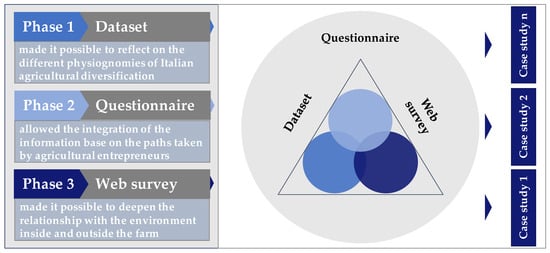
Figure 1.
The research techniques adopted (author: our elaboration).
Phase 1
In the initial phase of the work, the dataset of the Rural Excellence project [13] was used. It collects the experiences of the good use of EU funds to support rural development in the 2007–2013 programming period. The project, funded by the European Agricultural Fund for Rural Development (EAFRD), was developed as part of the Italian National Rural Network Programme which supports and integrates all the activities related to the development of rural areas.
The dataset groups a sample of 102 farms, scattered throughout the country and systematizes the experiences of using rather heterogeneous public resources within the II Pillar of the CAP. It ranges from supporting sustainable agricultural practices to landscape conservation and recovery of native cultivars to investments in structures and technologies up to diversification interventions and innovative forms of management.
The use of a consolidated dataset made it possible to overcome some of the limitations inherent in the monitoring systems used for the Structural Funds Programs and linked, above all, to the difficulties in retrieving data [29,30,31] relating to the gap between the commitments at the beginning of the programming and the actual expenses incurred for the projects [32]. Furthermore, the fact that a certain period of time has elapsed since the completion of the investments, has allowed the authors to rely on a pool of farms that, in addition to having passed the start-up phase, established formal and informal relationships with the market and networks on the territory.
From a general point of view, the observation of the data allowed the researchers to make some reflections on the different features of agricultural multifunctionality at the national level, on the paths taken by farmers, on the agronomic choices made as well as on the relational and entrepreneurial models put in place.
On the contrary to what is highlighted in the inter-census data [33], a renewed interest in agricultural activity emerges (46% of the sample is under 40) where almost 60% of new farmers did not previously carry out an agricultural activity. In the most cases, the transition to the agricultural sector is radical (Figure 2). Only a few individuals continue to carry out their previous work activities in a complementary manner to the agricultural one.
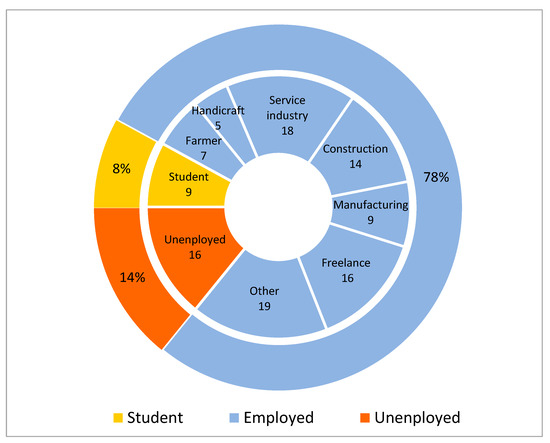
Figure 2.
The former job of the farmers of the “Eccellenze rurali” (Rural Excellence) dataset. Note: the outer ring shows the values in %; the inner ring expresses the absolute values (author: our elaboration).
Furthermore, depending on the type of access to land, the individuals in the sample are clearly divided between those who enter from scratch and those who continue their family activities. The establishment in the farm derives in 35% of cases from the sale by another farmer, mostly in the family and for the remaining part from the creation of a new business. This contributes to characterize the national context for a significant renewal of the sector, not only generational but also cultural, thanks to the entry of individuals with extra-agricultural experiences. What is briefly reported here shows how the primary sector can attract, also thanks to specific public policies, young people with previous and different work experiences such as services, industry, handicrafts and universities [34].
To arrive at the conceptualization of the analysis model, the researchers’ effort was aimed at identifying the parameters and the related explanatory characteristics, which make (or do not make) these multifunctional farms active subjects of the agroecological approach in Italy and pioneers of the Green Deal [35].
Taking into account that today agroecology no longer exclusively concerns the aspects of production and agricultural practices but incorporates various other dimensions (environmental, social, economic, ethical [16]), the choice of the analysis parameters fell on those most present in the literature and related to:
- agricultural production systems [4,5,16,17,36,37];
- community empowerment [2,12,15,16,38,39];
- networking [3,37,39,40,41].
The ethical dimension is crossing the model adopted [42,43,44]. In the dataset of the Rural Excellence project, the aspects related to farms responsibility towards community are particularly relevant. We refer to the environment protection, educational activities, the organization and involvement of local communities. To give some examples, re-connection among producers and consumers and re-vitalization of territorial identity linking with sustainable agriculture and socially responsible practices, are elements which have been dealt in the project, as well as, the environmental protection, inclusion of disadvantaged people and raising awareness of the rural areas problems. Furthermore, according to Farm to Fork strategy [45], the ethical issue (e.g., respect of animal welfare, trust relationship between producers and consumers of agri-food, environmental protection) is nowadays a prior topic in new EU common guidelines.
The parameters were then associated with a set of criteria, in variable numbers (Figure 3), better able to characterize the analysis model.
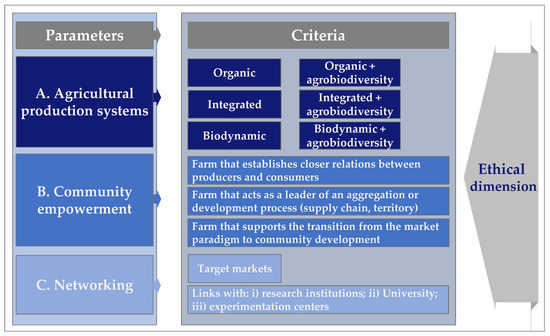
Figure 3.
Conceptual framework: criteria used in subsample selection (author: our elaboration).
The conceptualization of the model led to the reclassification of the multifunctional farms of the dataset. Conventional farms were excluded, maintaining only organic or integrated pest management farms, regardless of the existence of a certification.
Phase 2
On the basis of the conceptual model of analysis, it was decided to direct the research towards further quantitative and qualitative aspects, investigating, through a semi-structured questionnaire, the role of farmers as active subjects for food security and sovereignty and that of the agricultural sector as the main part of natural resources sustainable governance.
The observation of the analysis parameters and related criteria in the Rural Excellence dataset allowed to identify a sample of 30 multifunctional farms that are protagonists of the agroecological transition [46] at a national level.
The questionnaire consists of three sections, aimed at deepening the conceptual framework of analysis. More specifically:
- the first section made it possible to analyse the physical, economic and income data of the farms. At the same time, it was investigated the reasons and conditions under which individuals with different cultural and professional backgrounds leave their work activities to devote themselves professionally to agriculture and from which sectors of working activity they come. An attempt is therefore made to overcome the aspect linked to the mere agricultural production system;
- taking into account that there are no official regulations, certification or labelling systems for agroecological practices, nor a clear EU strategy on the subject, the second section helped to examine and, consequently, to identify the agricultural practices adopted as well as agri-environmental measures (e.g., conservation of habitats with high natural value, animal welfare, management of low-intensity grazing systems, etc.) followed by farmers that, as highlighted by Migliorini [17], prevent the risk of conventionalization;
- finally, aware that the sustainability of agricultural production and food systems necessarily pass from a closer relationship between farmers and consumers, the researchers focused on the enhancement of the human capital by verifying participation in research projects (public-private partnerships), as well as on the growth of the community social capital meant as collective learning, adoption of participatory approaches, network memberships. Indeed, the dissemination of information and knowledge on agroecological practices, as well as the creation and participation in territorial networks, is considered a qualifying element of the Italian case. All these aspects are also precursory with respect to the need to reduce the distance between rural areas, where agriculture plays a predominant role in economic development and the urban centres where the main demand for agricultural products and services is generated.
Phase 3
A web survey was used for the administration of the questionnaire.
This choice is linked, in addition to the advantages [47] compared to other methods of administering the questionnaires, not least the lower costs, to the characteristics of the respondents, particularly accustomed to using the internet [48].
Out of the sample of the selected farms, 20 offered their willingness to participate in the online questionnaire and three of them were selected as case studies.
The final phase of the study therefore used a purely qualitative survey technique by borrowing the methodology of the case study [28,49,50,51] from research in the field of social sciences. The method, which has also been widely used in the study of agricultural economics [52,53,54,55,56] was used for its explanatory capacity with respect to the parameters and criteria assumed in the analysis model. Furthermore, as demonstrated more recently in Borsellino et al. [57], the use of the case study is a useful tool to deepen the knowledge of the survey units.
5. Relations between Multifunctional Agriculture and Agroecological Approach
The 20 farms that responded to the online questionnaire are distributed throughout the country and operate in differentiated production areas and local systems: peri-urban areas (20%), hilly areas (55%), mountain areas (25%).
The analysis of the information collected, shows that these are multifunctional farms out of which 83% work by using sustainable production methods. More specifically, 66.7% of the farms use the organic method and 16.7% the biodynamic method (Figure 4), while the remaining part is distributed between conventional farms (8.2%) and farms that use integrated pest management and the principles of synergistic agriculture.
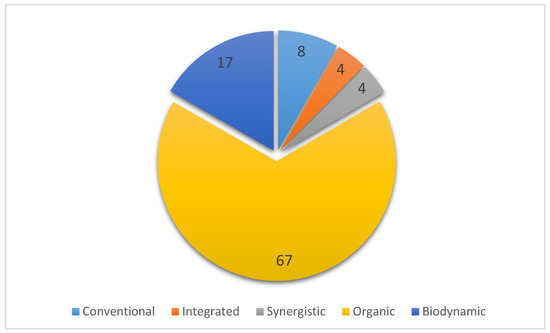
Figure 4.
Types of agricultural production implemented in the sample farms (values in%) (author: our elaboration).
With regard to the agronomic and defense techniques adopted, there is a certain orientation towards biological control and green manuring. The two techniques concern almost half of the farms (48%), which are echoed by fertilization with crop residues and tillage practices (Figure 5). The agroecological practices include a reduction in the use of external inputs and an improvement in the quality and use-efficiency of internal inputs [18].
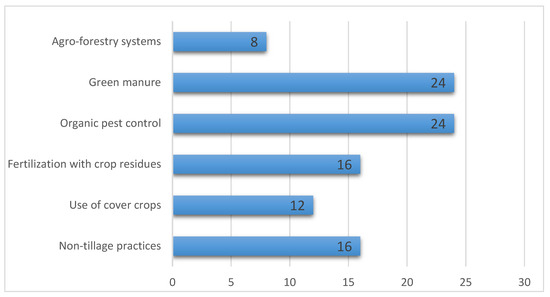
Figure 5.
Agronomic and defense techniques implemented in the sample farms (values in%) (author: our elaboration).
The 95% of the sample farms contain elements that favor biodiversity (e.g., hedges, ponds, wetlands, wooded surfaces, etc.)—according to the concept of high nature value farming (HNV), introduced in the early 1990s [58,59]—out of which 55% fall into protected areas and 70% of them boast species of wild or rare subject to protection regime flora and fauna. The detail of the semi-natural elements declared by the sample farms is shown in Figure 6.
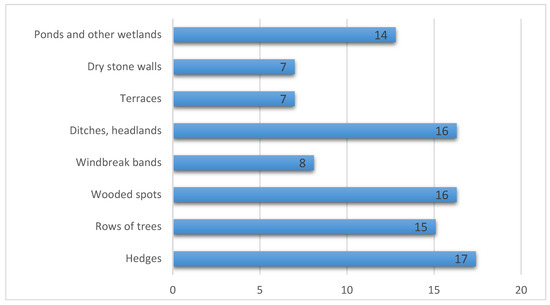
Figure 6.
Semi-natural elements present in the sample farms (values in%) (author: our elaboration).
The centrality of natural resources is recognized by farmers as an added value from both the strictly productive point of view and the offer of extra-agricultural activities and services, as well as from the side of environmental sustainability.
With a view to favoring the design and management of sustainable agroecosystems, the farmers interviewed pursue investment strategies to supporting biodiversity (32%), the reduction of the environmental impacts of production processes (30%), the reduction of the quantity of waste produced (17%) and almost all of them are engaged in the production of renewable energy (solar panels, geothermal plants).
The use of natural resources and ecological principles, as well as the closure of ecological cycles at the farm level, at the same time provide for the incorporation of socio-economic elements into the production processes. In this sense, the extra-agricultural activities carried out concern (Figure 7), mainly, the on-farm processing and sale of agricultural products, tourist accommodation associated with initiatives for sustainable use of the territory and the teaching farm, within which the courses focus on environmental themes, organic production, transformation processes of the products and knowledge of their typicality. The average number of classes hosted annually is around 33 (minimum value found 6, maximum value 70).

Figure 7.
Non-agricultural activities carried out in the sample farms (values in%) (author: our elaboration).
Non-agricultural activities constitute a double opportunity. On the one hand, they allow farmers to be able to acquire additional income, thus responding to the effects of the economic crisis and the consequent decline in income recorded in recent times. On the other hand, they contribute to increasing the degree of autonomy of the farmer by strengthening its economic and ecological resilience.
Openness to the outside, exchange and experimentation give greater dynamism to the multifunctional farms. The best income performances (Figure 8) are indeed found for those that have most diversified their activities (on average 5 non-agricultural activities). The different agroecological practices suggest it improves farming incomes and strengthens the resilience of farms and rural areas.
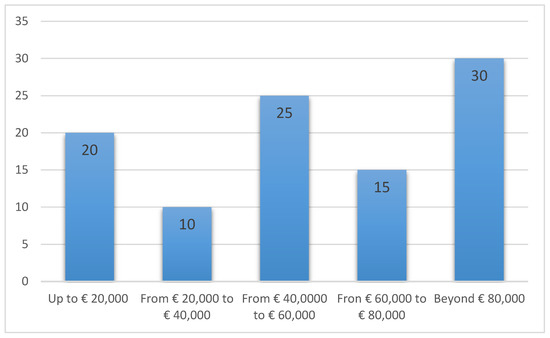
Figure 8.
Gross turnover in the sample farmer (values in %) (author: our elaboration).
Non-agricultural activities also make it possible to offer more services and contribute to improving the quality of life in rural areas. The enhancement of social resources and services (over 60% of the sample also carries out social agriculture activities), the enhancement and promotion of the existing environmental, historical and cultural heritage favor the improvement of the attractiveness of the area by supporting the local economy and strengthening the sense of belonging for the population to the territory [60,61,62].
The activity carried out by the sample farms, as revealed by the qualitative data collected in the field, had emulative effects on the territory [38,53,63]. In many cases, these are farms that act as a reference model for other farms and have driving and aggregating power in the construction of networks, whether commercial, institutional, scientific or related to other areas.
The multifunctional activity conducted is characterized by a notable manifestation of the principles of sustainability. For this reason, it contributes to disseminating the values of sustainable agriculture with activities such as farm visits, information activities or training courses and the creation, in many cases, of networks of relationships and collaborations with local actors, public bodies, associations of producers, research institutions, universities and schools.
All the farms in the sample include a vision of the agroecological approach that can be traced back to the parameters assumed in the analysis model: production systems, community empowerment and networking.
To make the incorporation of the variables considered even more evident, the researchers have identified, within the sample, three business realities distributed by:
- geographical area,
- context of intervention (environmental, economic and social),
- productive orientation,
- production size,
- business organization.
More specifically, as shown in Figure 9, “Cascina Forestina” in Lombardy, is a multifunctional farm just outside Milan in a peri-urban context. The “Porta dei Parchi” is located in the mountain area (Abruzzo). Finally, the “Fastuchera” operates in a flat area threatened with desertification, at the innermost part of Sicily in Cammarata in the province of Agrigento.
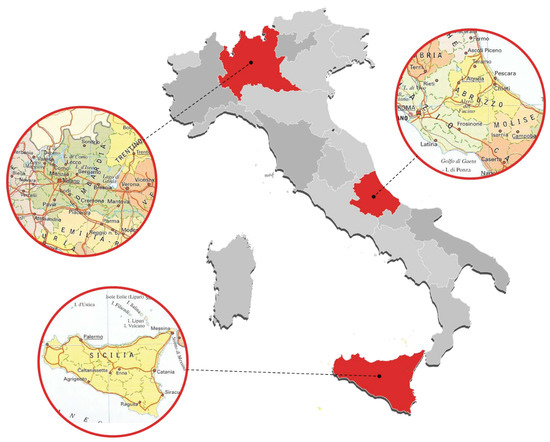
Figure 9.
Geographical location of the case studies: Lombardy, Abruzzo and Sicily.
Table 1 summarizes the reading of the agroecological and multifunctional dimension of the case studies.

Table 1.
Summary of case studies.
Although with wide and important differences, the three farms are able to make evident a concrete example of how these multifunctional farms have been carriers of the agroecological approach in Italy and pioneers of the dictates of the current Green Deal.
5.1. Agricultural Production Systems
The “Fastuchera” farm operates in Cammarata within the Agrigento area which is recognized as having a high natural value. It was founded in 2011 thanks to the careful recovery action of the farmer who started the agricultural activity while maintaining the characteristic habitats and landscapes intact. Its agroecological approach is expressed in all dimensions relating to multifunctionality. The farm declines its business in ecological terms, offering ecosystem services and producing energy from renewable, economic sources, with a short supply chain on the transformation of oil and flours and in social terms with relations with consumers and farmers’ networks. The latter element deserves to be adequately weighed given the extreme difficulty of the rural area in which the farm operates, an economically depressed area, with agriculture in progressive and rapid abandonment, marked depopulation, low coverage of business services, low propensity to cooperation and innovation. The Fastuchera farm represents an element of rupture with respect to a rural reality that can be defined as a problem. According to the opinion of the farmer, the agroecological approach today represents the only possible development way in the area and an element capable of contrasting the definitive abandonment of economic activities.
More specifically, the aspect related to the agroecological approach that deserves attention concerns agricultural production systems. The farm, located in an area severely threatened by desertification processes and subject to protection under the Habitats Directive, was launched thanks to an important recovery action. Centuries-old trees that survived the intensive agriculture which affected the area a few decades ago, have been put back into production with sustainable cultivation methods, respecting the productive vocation of the area. Olive, almond and pistachio groves (from which the name of the farm originates—“Fastuchera” in Sicilian dialect means pistachio grove) alternate with arable crops, legumes, forage also attributable to native varieties, according to the principles of rotation and organic farming.
The farmer’s attention and environmental sensitivity are fundamental elements in the recovery and enhancement of a site of environmental and historical importance (Sorgente Acqua Fitusa Site of Community Importance). The farm, as anticipated, operates in an area of high environmental value, characterized by the presence of a widespread flora represented by about 700 species, many of which are in danger of extinction and 12 types of natural habitats. This coexistence between agricultural activity and the environment represents a precise will of the farmer who has chosen to maintain environmental elements and characteristic landscape.
The recovery of ancient native grains, stone-ground, transformed and sold by the farmer, by creating a short supply chain and circuits of trust and direct relationships with consumers, are a further expression of the agroecology principles that permeate the business experience (Figure 10) and which are connected to the values of sustainability and organic practices. Agricultural diversification generally promotes win-win scenarios, simultaneously supporting crop yield and the provisioning of a concomitant ecosystem service category [64].
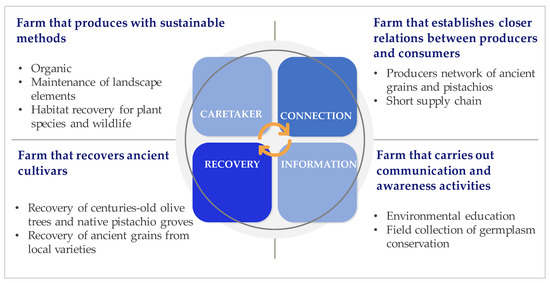
Figure 10.
Fastuchera: the determinants of the agricultural production systems (author: our elaboration).
The values of the farmer’s environmental action are considered by himself as edifying and satisfying as well as the economic value produced by the farm. The low environmental impact of agricultural activity in a context of high value is indeed considered a success factor.
Finally, it is important to point out that the farmer’s education influences his activity. He was educated in an extra-agricultural sector (coming from the academic world, specialized in linguistics). His professional profile contaminates and adds value to his role as a farmer as he is capable of insert in the dynamics of the agricultural “working,” elements of value acquired and tested elsewhere (importance of a sustainable vision of the economics and of the relations between agriculture and the environment, respect for natural cycles, rediscovery of traditions and links with the past).
5.2. Community Empowerment
The organic farm “La Porta dei Parchi” is located in Anversa degli Abruzzi, in the province of L’Aquila, at an altitude of 700 m, immersed in a typically mountain landscape and suited to breeding.
The farm was founded in 1977 from the idea of the farmer to be able to promote sustainable development and protection in mountain areas, creating job opportunities in a marginal context, investing in the natural and environmental heritage of the area.
The farmer has chosen to pursue its goal by investing in the recovery and promotion of a traditional approach to extensive sheep farming (the livestock stock is around 1500 heads), organic and focused on the recovery of native breeds. It is therefore a sustainable business orientation not only from production and management point of view but also in terms of local development and which has led the farm, over the years, to play a real active and propulsive role in the launch of initiatives and projects to support businesses and local supply chains and the territory as a whole.
The Figure 11 summarizes the factors that characterize the activity of the farm which, based on the model assumed for the analysis, operates following a vision of community empowerment.
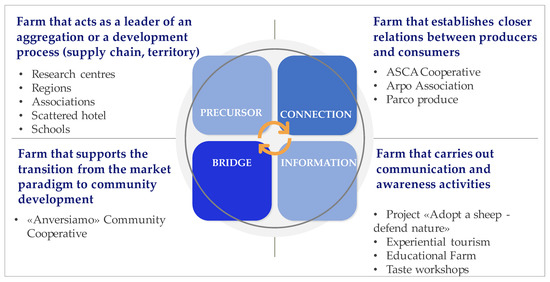
Figure 11.
La Porta dei Parchi: the determinants of the community empowerment (author: our elaboration).
The activity carried out to strengthen the local livestock production system is intense:
- with the role of promoter, he supported the establishment of a cooperative representing local livestock farms that adopt the traditional, organic and non-intensive methods;
- he created an association which today gathers 176 farms and a stock of over than 40,000 head of sheep;
- he supported the launch of a consortium aimed at consolidating the market position of high quality and authenticity typical products.
The development of the business chain was necessary to consolidate its sustainability over time. The start of subsequent non-agricultural activities (agritourism, dining, teaching farm) was driven by the need to enhance the endogenous resources of a highly marginal area, leveraging awareness of what nature offers spontaneously.
The networking and communication activity—which involved local authorities, research centers, local and non-local associations, schools and the local population—was carried out assiduously with the aim of providing not only concrete answers and solutions to the needs of the territory but also, and above all, to develop the potential that expresses the existing heritage of natural, cultural and food and wine resources.
With the project “Adopt a sheep—Defend nature,” for example, the farm attracted interest of the public opinion, national and international, on the problem of abandonment and degradation of the mountain areas and on the need to defend farming extensive techniques as they are able to guarantee the protection of biodiversity, the environment and the survival of the small urban centers in the area. The project provides, for the remote adoption of a sheep upon payment, an annual fee that guarantees the farmer the maintenance of the sheep and the adopter the possibility of receiving cheese, meat and wool during the year.
The attention paid to resilience in marginal areas has prompted the farm to promote collective action aimed at producing and delivering goods and services necessary to improve the quality of the living conditions of the population of the area, guaranteeing active supervision and sustainable area of the protected mountain area. In order to pursue these goals, the Anversiamo Community Cooperative was founded. Community businesses are characterized by pursuing the general interest of the whole community, without any kind of distinction or limitation (they are multi-actor), through the creation and integration of many different activities (they are multi-sectorial) [65].
Living and working in the mountains, pursuing sustainability criteria for the farmers and creators of the numerous initiatives implemented, was first and foremost a choice of life. Their willingness to invest according to these criteria is not limited to the agricultural sector. They pay particular attention to the impact of production and human presence on the environmental context but also to the territory in which the farmer operates through initiatives aimed at improving the quality of life of those who live there and make them more attractive.
5.3. Networking
“Cascina Forestina” is an organic farm founded in 1996 in the municipality of Cisliano, in Lombardy. The farm operates within the millenary “Bosco di Riazzolo” (Forest of Riazzolo) in the South Agricultural Park of Milan, where the environment is characterized by the presence of wooded areas, naturalistic oasis and sites of important environmental value. The presence of such a high-quality environmental value and natural cycles for agricultural activity has always been understood by the farmer.
Cascina Forestina clearly summarizes the three parameters assumed in the analysis model and attributable to the agroecological approach. The farm, organic since its launch, has made the positive relationship between agriculture and the environment its strength, by transforming it into a value for the farm and for the community.
Recovery of biodiversity (wild but also agricultural), valorization of natural elements and the landscape, education and environmental awareness, offer of ecosystem, and social services represent the farm core system. But it is on the farmer’s ability to create networks that the agroecological approach pursued most clearly emerges, which allows to contaminate many aspects, actors and relationships that he develops on a daily basis and that has managed to build and consolidate over time.
More specifically, as shown in Figure 12, the ability to create networks involves the whole relational sphere of the farm.
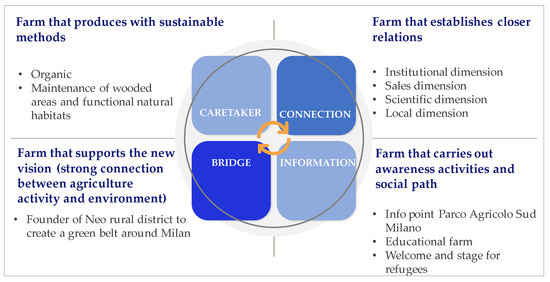
Figure 12.
Cascina Forestina: the determinants of networking (author: our elaboration).
The driving force in the establishment of the “Neorural District of the Three Waters” was significant, consisting of 40 farms operating in the area between the South Milan Park and the Ticino Park. The District was founded with the aim of creating a green belt around the city of Milan and restoring value to the environment and the community that insist on the metropolitan area, through the action of agriculture.
It should be noted that the role and activism of the farmer in networking actions and in the dissemination of the agroecology principles represent precise field choices.
The farm plays an active role in relations with customers and consumers, with the local environmental associations, in dialogue and exchange with the academic world, in collaborations with social partnerships and finally in the institutional relations with local authorities. Through the driving role of relations with the subjects described, the farm acts as a link between them. The relationships are based on the principles of responsibility towards the environment, on the ability to disseminate a sustainable vision of agricultural activity, on the responsibility towards the community.
The farmer multifunctionality finds declinations in relation to the services rendered to a plurality of subjects:
- consumers (not only agritourism, solidarity purchase groups and direct sales but also guided harvesting of vegetables in the field for visitors and customers);
- users of the territory (information point of the Parco Sud Milano);
- local institutions (refugee reception network);
- students (university students with degree theses and didactic education for primary and secondary schools);
- lovers of art and culture (proposition of cultural events to discover Virgil’s thought).
The farmer’s awareness of his role is clear since his choice to devote himself to farming, by recovering his grandfather’s farm that had been abandoned. The in-depth interview highlighted his extreme commitment, also in relations with local institutions, in placing greater attention on the merits of environmental and rural continuity of the territory and the reduction of the contrast between agricultural activity and environmental protection.
The farm’s wooded areas (which represent half of the total agricultural area) are considered a value by the farmer, a resource and not opposed to agricultural production. The specific microclimate condition which is created given the morphology of the territory—humid habitats, climatic factors, natural, insects—is useful for organic production and management. Respect and protection of the habitat, on which the farm strategy is clearly based, are not only the result of ethical choices but evidently meet utilitarian purposes, effectively transforming environmental conditions into an ally for a sustainability that is synthesized in the agroecological approach.
Finally, another element of interest is the added value that the farmer’s education path gives to the farm vision and the services offered, also the latter interpretations of the close (positive) relationship between agricultural activity and the environmental context. The degree in philology, indeed, contaminates the use of the woods, with the creation of ad hoc public events, including the Virgilian Paths, to discover the poet from the place who, since Roman times, has highlighted the profound human need for harmony with the nature.
6. Findings and Discussion
The new strategic orientations taken by the EU indicate a radical green shift. Indeed, the new course of the European Commission opened with the Green Deal, a real programmatic manifesto for the whole economy, with an important focus on the primary sector and the agri-food sector.
Promoting a bright, resilient and diversified agricultural sector, strengthening environmental protection, contributing to the achievement of environmental and climate objectives, strengthening the socio-economic fabric of the rural areas are the primary objectives of the European action. These principles find a clear declination in the agroecological approach when considering aspects of sustainability concerning the environment, the recovery of biodiversity, the importance of networking and relationships between actors, incentives for the exchange and circulation of innovations. Science, practice and movement, the cornerstones of the agroecological approach, find ample space in the documents that make up the new European strategy for 2030—Green Deal, Strategy for Biodiversity, Action for Climate, Farm to Fork—where they all stand the conditions for achieving an ecological transition that can no longer be postponed for the future.
In the light of the analysis conducted, multifunctional farms can be considered precursors of the approach which, from a theoretical point of view, identifies agroecology.
Research indicates that these farms act according to agroecological principles by supporting agricultural practices that take a certain distance from conventional agriculture and respecting habitats, landscapes, biodiversity of plants and animals, attentive to the recovery and reuse of natural resources.
The farmers interviewed attribute substantial importance to relations with local actors, be they consumers, users, institutions, the scientific world and act as an inspiring subject, bearer of a growing civil and environmental sensitivity. Multifunctional farms operate by applying principles of ethics that permeate their entire space for action, production, relational, commercial, informative and communicative.
Agricultural production systems, community empowerment and networking are identified by the analysis of the determinants that, while presenting with large and important differences between the farms in the sample, characterize the agroecological orientation of the same.
The analysis of the case studies also highlights some exogenous factors to the primary sector. In addition to the young age in the establishment phase (an average 32 years old young people for the case studies and 30 years for the 20 farms sample), a high level of education prevails among farmers and their origin from other economic sectors, which allows them to place different skills (professional, creative, relational) at the service of the primary sector, realizing innovative business strategies and good results in terms of income.
The impact of generational changes in agriculture is highly variable. To date, many studies conducted [34,66,67,68,69] have demonstrated the success, in cases of intra-family business transfer and in cases of business succession, of the factors such as age, gender, level of education, professional experience. This study confirms the importance of these exogenous factors.
In developing the analysis, some questions emerged for the scientific discipline of agroecology, such as: what concepts, models and methods need to be developed or adapted in order to deal with the definition of agroecology? Do we need new research competencies to deal with this more holistic approach?
Success of an agroecological improvement to farm diversification is given by a better use of local resources which emphasizes human capital enhancement and community empowerment through social learning and participatory methods, good linkages between farmers and external agencies, higher access to markets and income generating activities.
In most cases, farmers adopting agroecological practices achieved significant levels of income, market and conservation of natural resources. Given the benefits, why these benefits are not disseminated more widely? And how to achieve a significant increase in the knowledge and management of agroecological principles between farmers of varied socioeconomical conditions and between institutional actors involved in agricultural development?
One important factor which has limited the dissemination of the agroecological innovations is that the related principles that have determined the level of success of the local initiatives have not been analyzed or systematized yet. A starting point could be the understanding of the ecological and socioeconomic conditions under which agricultural alternatives have been adopted and implemented at local level. Moreover, in each country there are restraining factors such as lack of markets, lack of appropriate policies and technologies which could limit the scaling-up of such initiatives or represented an opportunity for their success at local levels and the removal of constraining factors [70,71].
The role that the new agricultural policy outlined by the European Commission can play to support the spread of the agroecological approach will be incisive. The resources of the CAP, integrated into the broad plan of the Green Deal, are indeed aimed at ensuring a fair and just green transition. To foster a rapid and necessary change, useful for achieving the ambitious European objectives, strategic actions are necessary that act on the definition of criteria and practices aimed at territorial specificities, on the institutional governance involved and provide for effective information and training actions for operators in the sector and of citizens. Raising awareness on environmental sustainability issues remains the real challenge awaiting the objectives of the Green Deal.
The aim of this research was to develop a conceptual model of analysis to explore how the agroecological approach (in terms of production of ecosystem services, tourism, social, maintenance of local culture, leadership in the territory) has been tested, even without a real decoding, in the Italian multifunctional farms. It would certainly be interesting, in the next future, to continue and to deepen the study also through the comparison with other European realities, especially in the Mediterranean countries (such as Greece, Spain, France), using our analysis model.
Additionally, it could be further explored the potential impact of other factors that may affect the agroecological paths undertaken by farms and rural areas, with reference to the use of natural resources, the adoption of techniques aimed at saving, reusing and recycling agricultural waste and other factors of production, services and infrastructures, which can facilitate and make the principles of agroecology more effective. Among these, an interesting aspect is certainly represented by the road infrastructures of the rural and forest road network that provide access to the agricultural farm. It is widely known that forest roads and more specifically the rural roads significantly affect the hydrological processes of the watersheds [72], the ecohydrological disturbances such as the stream water pollution associated with roads [73] and soil erosion [74]. The heavy traffic of rural roads in combination with heavy machinery exacerbates the soil erosion and the surface run off.
Author Contributions
Project, methodology, data processing and writing; G.G., F.L., M.V. and B.Z. All authors have read and agreed to the published version of the manuscript.
Funding
This research received funding from the Italian Network for Rural Development 2014–2020, Fiche 2.1 “Eccellenze rurali,” co-financed by European agricultural fund for rural development. This project is managed by the Italian Ministry of Agricultural, Agri-food and Forestry Policies (Mipaaf).
Institutional Review Board Statement
Not applicable.
Informed Consent Statement
Not applicable.
Data Availability Statement
The full dataset is available on the web site www.reterurale.it/eccellenze. More information and the full data can be required to the authors of present work.
Acknowledgments
The authors thank the Italian Ministry of Agricultural, Agri-food and Forestry Policies for supporting this study and all the multifunctional farms that involved in the survey for providing the fundamental information basis of this work. The authors also thank Marta Striano for the valuable contribution in organizing the dataset.
Conflicts of Interest
The authors declare no conflict of interest.
References
- Wezel, A.; Herren, B.G.; Kerr, R.B.; Barrios, E.; Gonçalves, A.L.R.; Sinclair, F. Agroecological principles and elements and their implications for transitioning to sustainable food systems. A review. Agron. Sustain. Dev. 2020, 40, 1–13. [Google Scholar] [CrossRef]
- Francis, C.; Lieblein, G.; Gliessman, S.; Breland, T.A.; Creamer, N.; Harwood, R.; Salomonsson, L.; Helenius, J.; Rickerl, D.; Salvador, R.; et al. Agroecology: The Ecology of Food Systems. J. Sustain. Agric. 2003, 22, 99–118. [Google Scholar] [CrossRef]
- Méndez, V.E.; Bacon, C.M.; Cohen, R. Agroecology as a Transdisciplinary, Participatory, and Action-Oriented Approach. Agroecol. Sustain. Food Syst. 2013, 37, 3–18. [Google Scholar] [CrossRef]
- Altieri, M.A. Agroecology. The Science of Sustainable Agriculture, 2nd ed.; Farrell, J.G., Hecht, S.B., Liebman, M., Magdoff, F., Murphy, B., Norgaard, R.B., Sikor, T.O., Eds.; CRC Press: Boca Raton, FL, USA, 1995; ISBN 978-08-133-1718-2. [Google Scholar]
- van der Ploeg, J.D.; Barjolle, D.; Bruil, J.; Brunori, G.; Madureira, L.M.C.; Dessein, J.; Drąg, Z.; Kessler, F.A.; Gasselin, P.; de Molina, M.G.; et al. The economic potential of agroecology: Empirical evidence from Europe. J. Rural Stud. 2019, 71, 46–61. [Google Scholar] [CrossRef]
- Di Iacovo, F. New trends in the relationship between farmers and local communities in Tuscany. In Multifunctional Agriculture: A New Paradigm for European Agriculture and Rural Development; Van Huylenbroeck, G., Durand, G., Eds.; Ashgate Pub Ltd.: Aldershot, UK, 2003; pp. 129–142. ISBN 0754635767. [Google Scholar]
- Aguglia, L.; Henke, R.; SalvionI, C. Multifunctional Agriculture. Entrepreneurial Behaviours and Strategies in the Search for Diversification; Edizioni Scientifiche Italiane: Naples, Italy, 2008; pp. 7–108. ISBN 978-88-495-1831-3. [Google Scholar]
- Salvioni, C.; Ascione, E.; Henke, R. Structural and Economic Dynamics in Diversified Italian Farms. Bio-Based Appl. Econ. 2013, 2, 257–275. [Google Scholar] [CrossRef]
- Bartolini, F.; Andreoli, M.; Brunori, G. Explaining determinants of the on-farm diversification: Empirical evidence from Tuscany region. Bio-Based Appl. Econ. 2014, 3, 477–493. [Google Scholar] [CrossRef]
- Giaccio, V.; Mastronardi, L.; Marino, D.; Giannelli, A.; Scardera, A. Do Rural Policies Impact on Tourism Development in Italy? A Case Study of Agritourism. Sustainability 2018, 10, 2938. [Google Scholar] [CrossRef]
- Sturla, A.; Viganò, E.; Viganò, L. The Organic Districts in Italy. An Interpretative Hypothesis in the Light of the Common Pool Resources Theory. Econ. Agro-Aliment. 2019, 21, 459–480. [Google Scholar] [CrossRef]
- Basile, S.; Nicoletti, D.; Paladino, A. Rapporto Sull’approccio All’agro-Ecologia in Italia; Osservatorio Europeo del Paesaggio: Padula, Italy, 2016. [Google Scholar]
- Verrascina, M. Alla scoperta delle Eccellenze rurali. In Rete Rurale Nazionale; MiPAAF: Roma, Italy, 2016. [Google Scholar]
- European Commission. Towards a sustainable Europe by 2030. In Reflection Paper; EU Publications Office: Luxembourg, 2019; ISBN 978-92-79-98963-6. [Google Scholar]
- Bellon, S.; Ollivier, G. Institutionalizing Agroecology in France: Social Circulation Changes the Meaning of an Idea. Sustainability 2018, 10, 1380. [Google Scholar] [CrossRef]
- Wezel, A.; Bellon, S.; Doré, T.; Francis, C.; Vallod, D.; David, C. Agroecology as a science, a movement and a practice. A review. Agron. Sustain. Dev. 2009, 29, 503–515. [Google Scholar] [CrossRef]
- Migliorini, P.; Wezel, A. Converging and diverging principles and practices of organic agriculture regulations and agroecology. A review. Agron. Sustain. Dev. Vol. 2017, 37, 63. [Google Scholar] [CrossRef]
- Wezel, A.; Casagrande, M.; Celette, F.; Vian, J.F.; Ferrer, A.; Peigné, J. Agroecological practices for sustainable agriculture. A review. Agron. Sustain. Dev. 2014, 34, 1–20. [Google Scholar] [CrossRef]
- European Court of Auditors. Greening: A more Complex Income Support Scheme, not yet Environmentally Effective; Special Report no. 21; EU Publications Office: Luxembourg, 2017. [Google Scholar]
- European Commission. Proposal for a Regulation Establishing Rules on Support for Strategic Plans; COM/2018/392 final; EU Publications Office: Luxembourg, 2018. [Google Scholar]
- Terluin, I.J. Differences in economic development in rural regions of advanced countries: An overview and critical analysis of theories. J. Rural Stud. 2003, 19, 327–344. [Google Scholar] [CrossRef]
- Pose, R.A.; Fratesi, U. Between development and social policies: The impact of European Structural Funds in Objective 1 Regions. Reg. Stud. 2004, 38, 97–113. [Google Scholar] [CrossRef]
- Hodge, I.; Midmore, P. Models of rural development and approaches to analysis evaluation and decision-making. Économie Rural. 2008, 307, 23–38. [Google Scholar] [CrossRef]
- Esposti, R.; Sotte, F. Evaluating the effectiveness of agricultural and rural policies: An introduction. Eur. Rev. Agric. Econ. 2013, 40, 535–539. [Google Scholar] [CrossRef]
- OECD. Multifunctionality: Towards an Analytical Framework; OECD: Paris, France, 2001. [Google Scholar]
- OECD. Multifunctionality: The Policy Implications; OECD: Paris, France, 2003. [Google Scholar]
- Kahwati, L.C.; Kane, H.L. Qualitative Comparative Analysis in Mixed Methods Research and Evaluation. In Mixed Methods Research Series; Sage: Los Angeles, CA, USA, 2019; ISBN 978-15063-9021-5. [Google Scholar]
- Bezzi, C. Il Nuovo Disegno Della Ricerca Valutativa; Franco Angeli Editore: Milano, Italy, 2016; ISBN 978-88-568-2201-4. [Google Scholar]
- Schuh, B.; Lukesch, R.; Michaelk, J.; Kaufmann, P.; Pufahl, A.; Schiller, S.; Koorberg, P.; Beaufoy, G.; Pinay, G.; Moran, D.; et al. Approaches for assessing the impacts of the Rural Development Programmes in the context of multiple intervening factors. Presented at the 122nd Seminar of the European Association of Agricultural Economists, Ancona, Italy, 17–18 February 2011. [Google Scholar]
- Andersson, A.; Höjgård, S.; Rabinowicz, E. Evaluation of results and adaptation of EU Rural Development Programmes. Land Use Policy 2017, 67, 298–314. [Google Scholar] [CrossRef]
- Licciardo, F.; De Vivo, C. Le politiche di sviluppo rurale nei piccoli comuni della Basilicata. Politiche Soc. 2017, 2, 259–282. [Google Scholar] [CrossRef]
- Cagliero, R.; Cristiano, S.; Pierangeli, F. La valutazione della qualità della vita nelle aree rurali. Agriregionieuropa 2011, 26, 5–9. [Google Scholar]
- ISTAT-Istituto Nazionale di Statistica. 6° Censimento Generale dell’Agricoltura; ISTAT: Roma, Italy, 2010. [Google Scholar]
- Domi, S.; Belletti, G.; Xhoxhi, O. Agritourism performance in Tuscany: The role of location, agripreneur and agritourism characteristics. Presented at the 174th EAAE Seminar Economics of Culture and Food in Evolving Agri-Food Systems and Rural Areas, Matera, Italy, 10–12 October 2019; European Commission: Matera, Italy, 2019. [Google Scholar]
- The European Green Deal. Communication from the Commission 2019, 640 final; EU Publications Office: Luxembourg, 2019. [Google Scholar]
- Migliorini, P.; Galioto, F.; Chiorri, M.; Vazzana, C. An integrated sustainability score based on agroecological and socioeconomic indicators. A case study of stockless organic farming in Italy. Agroecol. Sustain. Food Syst. 2018, 42, 859–884. [Google Scholar] [CrossRef]
- Wezel, A.; Goette, J.; Lagneaux, E.; Passuello, G.; Reisman, E.; Rodier, C.; Turpin, G. Agroecology in Europe: Research, Education, Collective Action Networks, and Alternative Food Systems. Sustainability 2018, 10, 1214. [Google Scholar] [CrossRef]
- Belliggiano, A.; Sturla, A.; Vassallo, M.; Viganò, L. Neo-endogenous rural development in favor of organic farming: Two case studies from Italian fragile areas. Eur. Countrys. 2020, 12, 1–29. [Google Scholar] [CrossRef]
- Wezel, A.; Goris, M.; Bruil, J.; Félix, G.F.; Peeters, A.; Bàrberi, P.; Bellon, S.; Migliorini, P. Challenges and Action Points to Amplify Agroecology in Europe. Sustainability 2018, 10, 1598. [Google Scholar] [CrossRef]
- Barberi, P.; Bocchi, S. Agroecology and Organic Agriculture: Opportunities for Innovative Agronomic Research. Presented at the 47th Congress of the Italian Society of Agronomy (SIA), Marsala, Italy, 13 September 2018. [Google Scholar]
- Sottile, F.; Peano, C. Agricoltura Slow; Slow Food Editore: Bra, Italy, 2017. [Google Scholar]
- Ammirato, S.; Felicetti, A.M.; Raso, C.; Pansera, B.A.; Violi, A. Agritourism and Sustainability: What We Can Learn from a Systematic Literature Review. Sustainability 2020, 12, 9575. [Google Scholar] [CrossRef]
- Pascale, A. Etica e agricoltura per un nuovo welfare rigenerativo. Agriregionieuropa 2005, 1, 17–19. [Google Scholar]
- Sikora, J.; Kaczocha, W.; Ważyńska, W.A. Values and professional and ethical norms in rural tourism in Poland. Agric. Econ. Czech. 2015, 61, 377–392. [Google Scholar] [CrossRef]
- A Farm to Fork Strategy for a Fair, Healthy and Environmentally-Friendly Food System; Communication from the Commission 381 final; EU Publications Office: Luxembourg, 2020.
- Titonell, P. Assessing resilience and adaptability in agroecological transitions. Agric. Syst. 2020, 184, 1–11. [Google Scholar] [CrossRef]
- Wright, K.B. Researching Internet-Based Populations: Advantages and Disadvantages of Online Survey Research, Online Questionnaire Authoring Software Packages, and Web Survey Services. J. Comput. Mediat. Commun. 2017, 10. [Google Scholar] [CrossRef]
- Cooper, M.P. Designing Effective Web Surveys; Cambridge University Press: New York, NY, USA, 2008. [Google Scholar] [CrossRef]
- Patton, M.Q. Qualitative Research and Evaluation Methods, 3rd ed.; Sage: Thousand Oaks, CA, USA, 2002; ISBN 978-14-129-7212-3. [Google Scholar]
- Simons, H. Case Study Research in Practice; Sage: London, UK, 2009. [Google Scholar] [CrossRef]
- Yin, R.K. Case Study Research Design and Methods, 5th ed.; Sage: Thousand Oaks, CA, USA, 2014. [Google Scholar] [CrossRef]
- van der Ploeg, J.D. The New peasantries: Struggles for autonomy and Sustainability in an Era of Empire and Globalization; Earthscan: London, UK, 2008; ISBN 978-1-84407-558-4. [Google Scholar]
- Buscemi, V.; Felici, F.; Licciardo, F.; Legnini, M.; Mappa, O. Il percorso di ascolto del territorio attraverso l’approccio alla valutazione partecipata: L’esperienza della valutazione in itinere del PSR Liguria 2007–2013. In Rassegna Italiana di Valutazione; Franco Angeli Editore: Milano, Italy, 2013; Volumes 56–57, pp. 121–140. [Google Scholar] [CrossRef]
- Randelli, F.; Romei, P.; Tortora, M. An evolutionary approach to the study of rural tourism: The case of Tuscany. Land Use Policy 2014, 38, 276–281. [Google Scholar] [CrossRef]
- Knickel, K.; Ashkenazy, A.; Chebach, T.C.; Parrot, N. Agricultural modernization and sustainable agriculture: Contradictions and complementarities. Int. J. Agric. Sustain. 2017, 15, 575–592. [Google Scholar] [CrossRef]
- do Adro, F.; Franco, M. Rural and agri-entrepreneurial networks: A qualitative case study. Land Use Policy 2020, 99, 1–10. [Google Scholar] [CrossRef]
- Borsellino, V.; Varia, F.; Zinnati, C.; Schimenti, E. The strategic choices and performance analyses of a case study. Int. J. Wine Bus. Res. 2020, 32, 391–421. [Google Scholar] [CrossRef]
- Baldock, D.; Beaufoy, G.; Bennett, G.; Clark, J. Nature Conservation and New Directions in the EC Common Agricultural Policy: The Potential Role of EC Policies in Maintaining Farming and Management Systems of High Nature Value in the Community; Institute for European Environmental Policy (IEEP): London, UK, 1993. [Google Scholar]
- Andersen, E.; Baldock, D.; Bennet, H.; Beaufoy, G.; Bignal, E.; Brower, F.; Elbersen, B.; Eiden, G.; Godeschalk, F.; Jones, G.; et al. Developing a High Nature Value Indicator; Consultancy report to the European Environment Agency (EEA): Copenhagen, Denmark, 2003; pp. 1–75. [Google Scholar]
- Ashkenazy, A.; Chebach, T.C.; Knickel, K.; Peter, S.; Horowitz, B.; Offenbach, R. Operationalising resilience in farms and rural regions e Findings from fourteen case studies. J. Rural Stud. 2018, 59, 211–221. [Google Scholar] [CrossRef]
- Knickel, K.; Redman, M.; Darnhofer, I.; Ashkenazy, A.; Chebach, T.C.; Sumane, S.; Tisenkopfs, T.; Zemeckis, R.; Atkociuniene, V.; Rivera, M.; et al. Between aspirations and reality: Making farming, food systems and rural areas more resilient, sustainable and equitable. J. Rural Stud. 2018, 59, 197–210. [Google Scholar] [CrossRef]
- Gretter, A.; Della Torre, C.; Maino, F.; Omizzolo, A. New Farming as an Example of Social Innovation Responding to Challenges of Inner Mountain Areas of Italian Alps. J. Alp. Res. 2019, 107, 1–16. [Google Scholar] [CrossRef]
- Esparcia, J. Innovation and networks in rural areas. An analysis from European innovative projects. J. Rural Stud. 2014, 34, 1–14. [Google Scholar] [CrossRef]
- Tamburini, G.; Bommarco, R.; Wanger, T.C.; Kremen, C.; van der Heijden, M.G.A.; Liebman, M.; Hallin, S. Agricultural diversification promotes multiple ecosystem services without compromising yield. Sci. Adv. 2020, 6, 1–8. [Google Scholar] [CrossRef] [PubMed]
- Euricse. Imprese di comunità e beni comuni. In Un Fenomeno in Evoluzione; Euricse Research Reports: Trento, Italy, 2020. [Google Scholar]
- Glauben, T.; Petrick, M.; Tietje, H.; Weiss, C. Probability and timing of succession or closure in family firms: A switching regression analysis of farm households in Germany. Appl. Econ. 2009, 41, 45–54. [Google Scholar] [CrossRef]
- Cavicchioli, D.; Bertoni, D.; Pretolani, R. Farm succession at a crossroads: The interaction among farm characteristics, labour market conditions, and gender and birth order effects. J. Rural Stud. 2018, 61, 73–83. [Google Scholar] [CrossRef]
- Ascione, E.; Tarangioli, S.; Zanetti, B. Nuova imprenditoria per l’agricoltura italiana. In Caratteri, Dinamiche e Strutture Aziendali; INEA: Roma, Italy, 2014; pp. 21–24. ISBN 9788881454396. [Google Scholar]
- Millán, J.M.; Congregado, E.; Román, C. Entrepreneurship persistence with and without personnel: The role of human capital and previous unemployment. Int. Entrep. Manag. J. 2014, 10, 187–206. [Google Scholar] [CrossRef]
- Altieri, M.A. Agroecology: A New Research and Development Paradigm for World Agriculture. Agric. Ecosyst. Environ. 1989, 27, 37–46. [Google Scholar] [CrossRef]
- Altieri, M.A. Review. Agroecology: The science of natural resource management for poor farmers in marginal environments. Agric. Ecosyst. Environ. 2002, 93, 1–24. [Google Scholar] [CrossRef]
- Kastridis, A. Impact of Forest Roads on Hydrological Processes. Forests 2020, 11, 1201. [Google Scholar] [CrossRef]
- Wemple, B.C.; Browning, T.; Ziegler, A.D.; Celi, J.; Chun, K.P.S.; Jaramillo, F.; Leite, N.K.; Ramchunder, S.J.; Palomeque, X.; Sawyer, D. Ecohydrological disturbances associated with roads: Current knowledge, research needs, and management concerns with reference to the tropics. Ecohydrology 2018, 11, 1881. [Google Scholar] [CrossRef]
- Benda, L.; James, C.; Miller, D.; Andras, K. Road Erosion and Delivery Index (READI): A model for evaluating unpaved roaderosion and stream sediment delivery. J. Am. Water Resour. Assoc. 2019, 55, 459–484. [Google Scholar] [CrossRef]
Publisher’s Note: MDPI stays neutral with regard to jurisdictional claims in published maps and institutional affiliations. |
© 2021 by the authors. Licensee MDPI, Basel, Switzerland. This article is an open access article distributed under the terms and conditions of the Creative Commons Attribution (CC BY) license (http://creativecommons.org/licenses/by/4.0/).